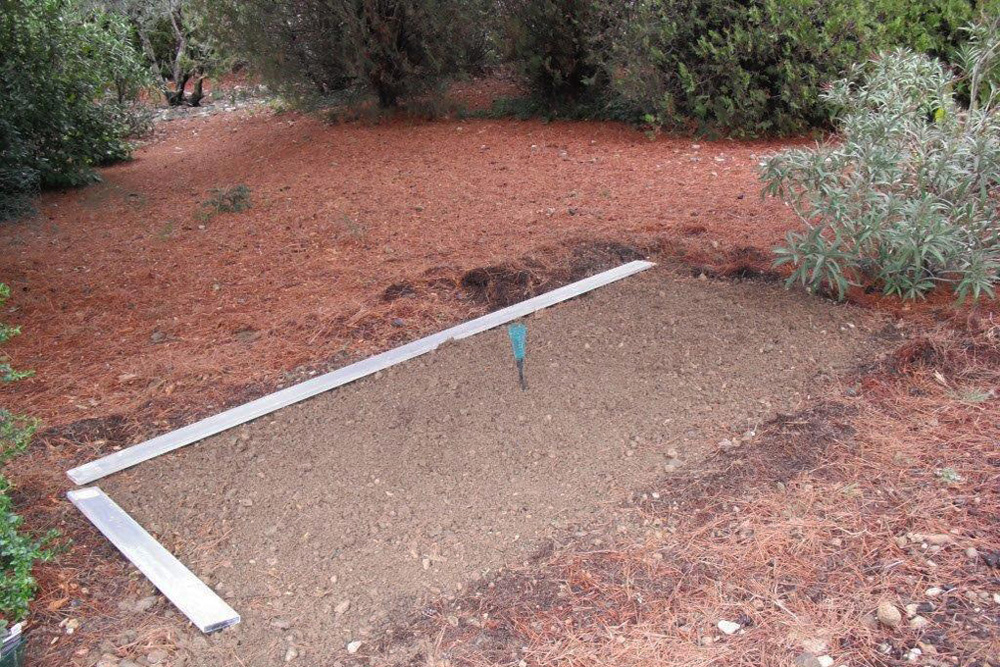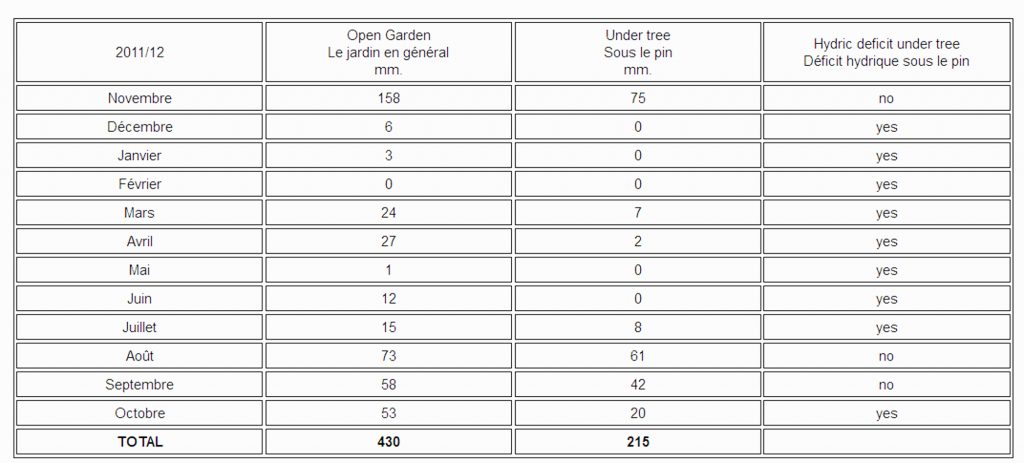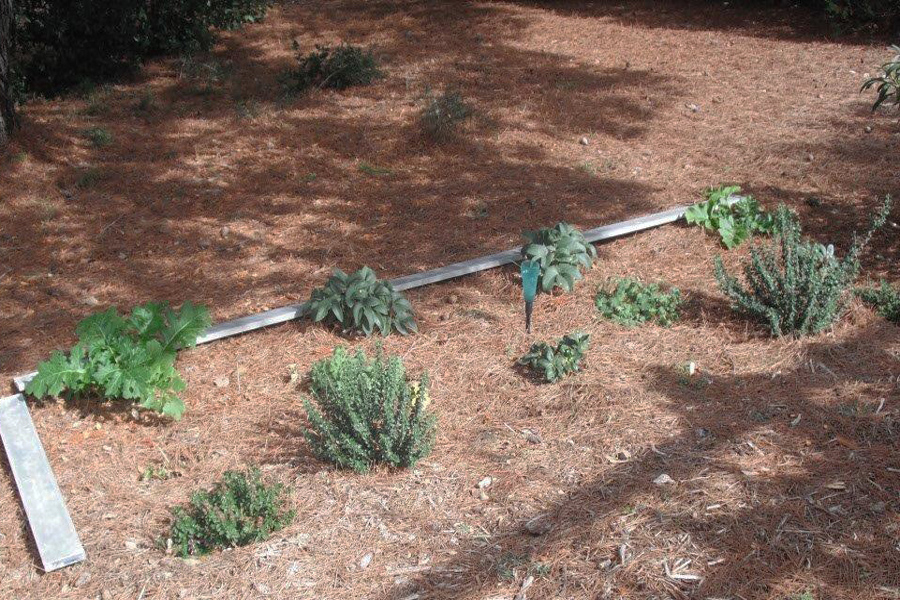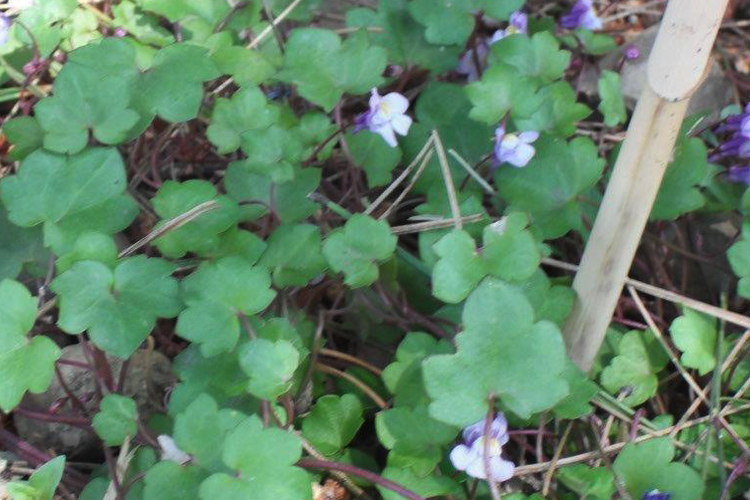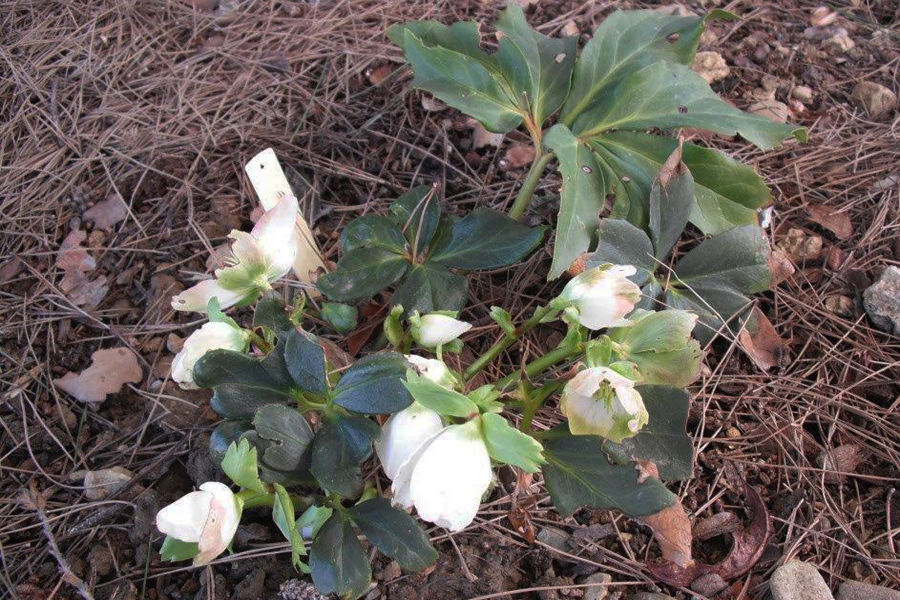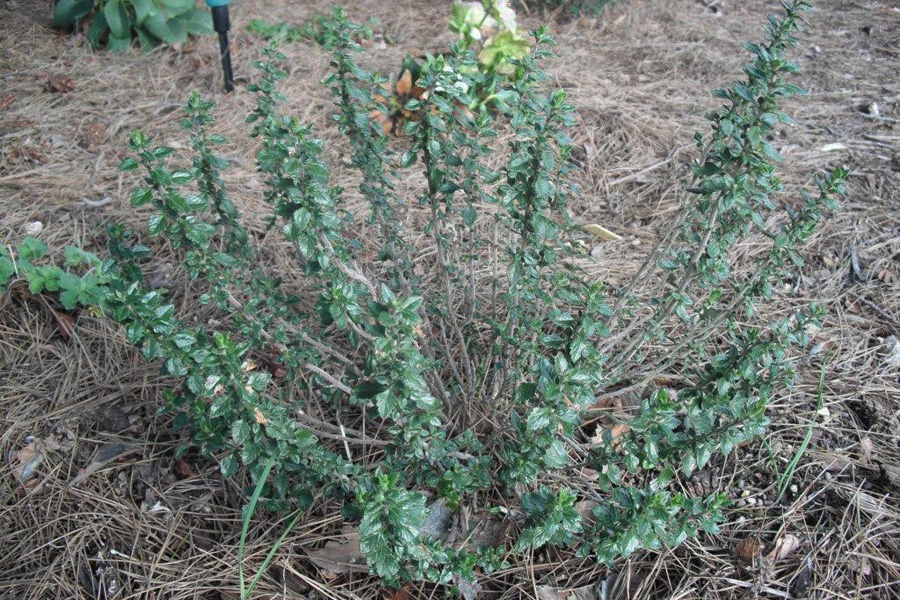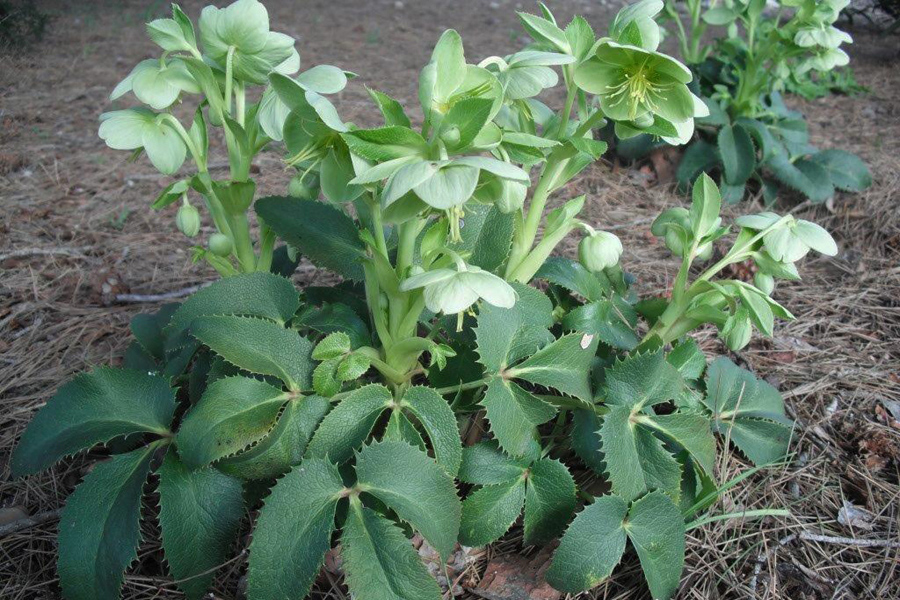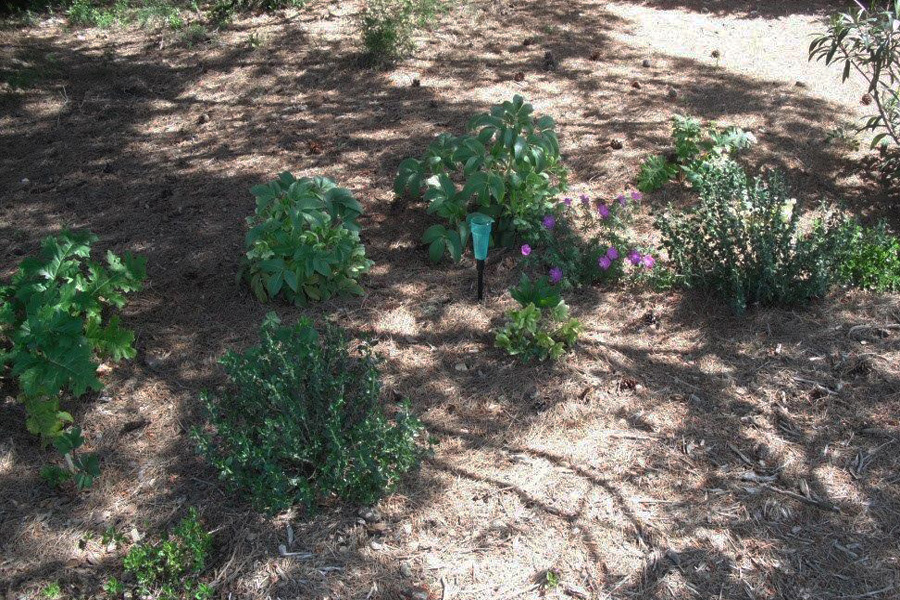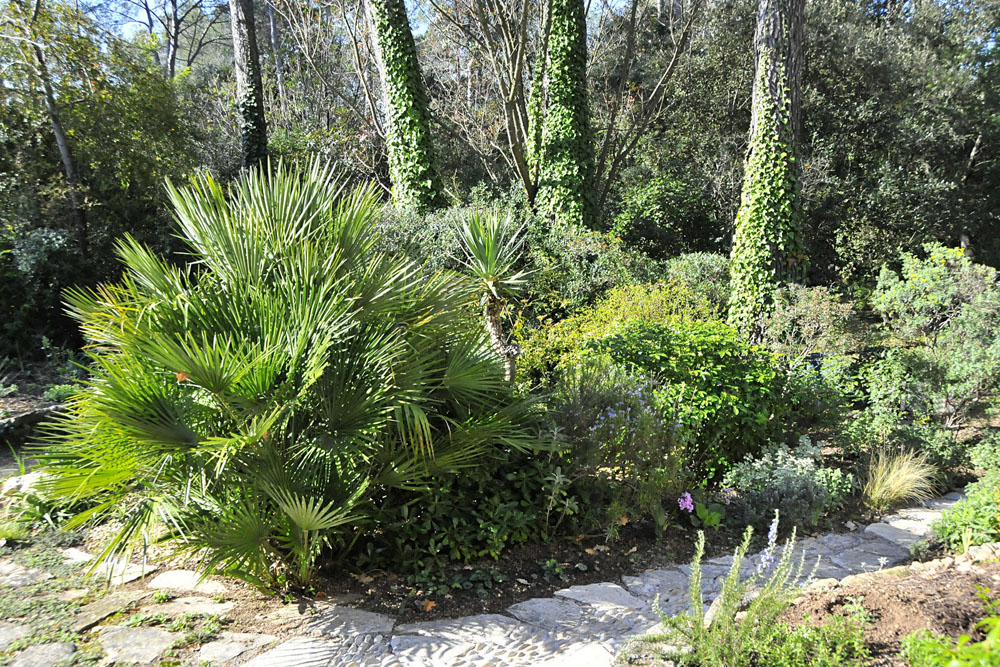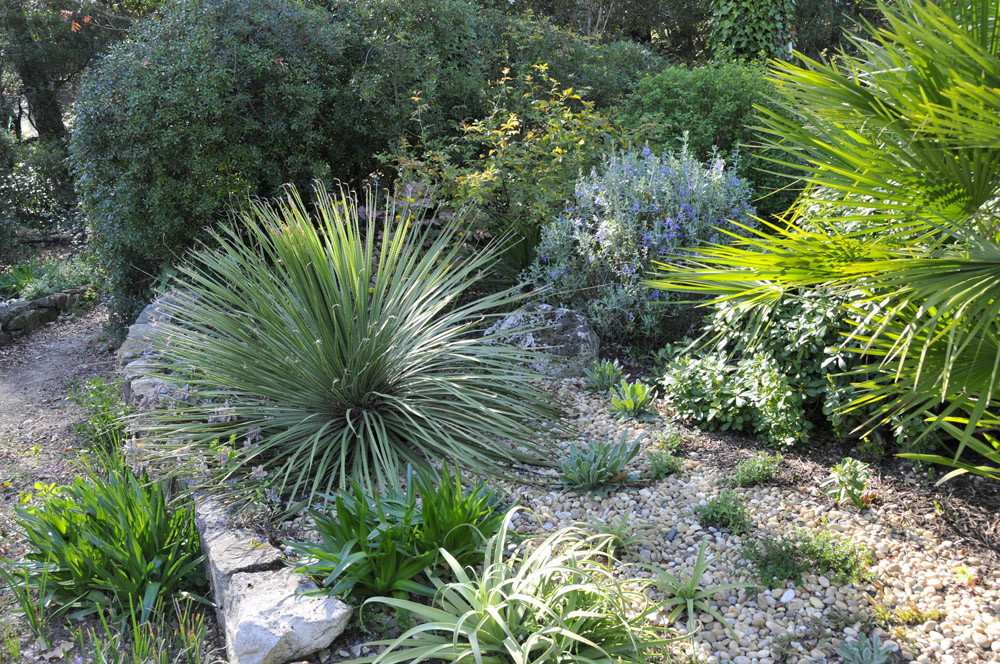Plants / Plantes
Plants for under Pine Trees / Planter sous les Pins
Click on the images to enlarge them / Cliquez sur les images pour les agrandir
Preliminary Report – February 2013 Rapport préliminaire – Février 2013
Background
During the general discussions following the 2011 AGM, somewhat naively I asked whether anyone could recommend plants suitable for growing under pine trees. This led to the compilation, from members’ personal experiences, of a list of suitable candidates. I decided to put some of these suggestions to test in my garden.
Prémices
Lors de la discussion qui a suivi l’assemblée générale 2011, j’ai naïvement demandé si quelqu’un pouvait recommander des plantes adaptées à la plantation sous des pins. Cela a conduit à la compilation, issue des expériences personnelles de certains membres, de plantes adéquates. Je décidais alors de tester dans mon jardin certaines de ces suggestions.
The site
The experimental plot chosen, 3m x 1m, is situated under a mature Pinus halpensis, around 75 years old and 12m in height. The plot is around 3m from the base of the tree and a similar distance in from the drip line. The tree is the last in a short row of mature trees with a group of established Thuja orientalis planted close by, on the eastern side. The test plot has a southerly aspect and receives some sun from late autumn to early spring. The garden soil is stony, heavy clay, generally alkaline, but underneath the pine trees it has, over the years, been reduced to the slightly acidic side of neutral (6.8 to 7.0) by the decomposing organic materia
L’emplacement
La parcelle d’expérimentation choisie, 3m x 1m, se trouve sous un pin adulte Pinus halepensis, âgé de 75 ans et s’élevant à 12m. Elle est à 3m environ du tronc et à une distance similaire du tuyau de goutte-à-goutte. Cet arbre est le dernier d’une haie composée d’arbres adultes incluant un groupe de Thuja orientalis bien établis et se trouvant côté est. La parcelle-test se trouve donc face au sud et profite du soleil à partir de la fin de l’automne jusqu’au début de printemps. La terre est caillouteuse, composée d’argile plutôt calcaire, mais sous les pins, elle est devenue, au fil des ans, presque acide (6,8 à 7) en raison de la matière organique décomposée.
Autumn 2011
Automne 2011
Plot preparation
The “thatch” of fresh and partially decayed pine needles was raked aside and after a thorough watering the soil was forked over to a depth of 20/25cms, limited by the network of tree roots. This was followed by the addition of 60g/m² of a general-purpose inorganic fertiliser. For comparison purposes, 2 simple rain gauges were installed, 1 in the centre of the plot and the second some 10m away in the open garden.
Préparation de la parcelle
Le tapis d’aiguilles de pins presque pourries a été ratissé et après un ample arrosage, la terre a été bêchée sur une profondeur de 20/25 cm, ceci étant limité par le réseau racinaire. Il a été ensuite ajouté un engrais de fonds non organique. À des fins de comparaison, 2 pluviomètres simples ont été installés, 1 au milieu du massif et le deuxième à environ 10 m de là au milieu du jardi
Plants chosen
The plants listed below were chosen based on members’ recommendations or selected from Olivier Filippi’s The Dry Gardening Handbook:
Plantes choisies
Les plantes ci-dessous furent choisies à partir de la liste des membres ou du livre d’Olivier Filippi « Pour un Jardin sans arrosage »:
Acanthus mollis
Cymbalaria muralis
Geranium sanguineum
Helleborus argutifolius
Helleborus niger
Teucrium chamaedrys
Teucrium x lucidrys
The opportunity to plant was taken following the first significant rainfall in late October. During this time a total of 66mm of rain fell in the open garden area of which some 37mm fell on the experimental plot.
La plantation eut lieu après les premières pluies fin octobre. A cette époque le montant des pluies s’éleva à 66 mm dans le jardin mais seulement 37 mm dans la parcelle d’expérimentation.
Climatic conditions during the trial
There was an unusually severe and prolonged cold period in February 2012, accompanied by a strong and gusty tramontane wind. This severe weather coincided with a long period of little or no rainfall.
Conditions climatiques pendant la période de test
Il y eut une période de froid exceptionnellement longue et sévère en février 2012, accompagnée de fortes rafales de tramontane. Ce temps sévère a coïncidé avec une longue période de peu ou pas de précipitations.
Rainfall
Rainfall was recorded each month both in the open garden and in the centre of the experimental plot. The monthly and annual totals, in millimetres are tabulated below. The table also shows the months where the plants would be suffering from hydric deficit, defined as months where the average temperature in degrees Celsius is greater than half of the precipitation in millimetres. This was found to be the case for 9 out of the 12 months. The plants were watered as necessary to ensure their survival.
Les chutes de pluie
Le niveau de pluviométrie fut enregistré chaque mois à la fois dans le jardin et au milieu de la parcelle-test. Les quantités annuelles et mensuelles se trouvent dans le tableau ci-dessous. Le tableau fait apparaître également les mois où les plantes auraient pu souffrir d’un déficit en eau, en se basant sur les mois où la température moyenne en degré Celsius est supérieure à la moitié des précipitations en millimètres. Cela fut le cas de 9 mois sur 12. Les plantes furent arrosées, bien entendu, afin de permettre leur survie.
Observations
Over 12 months the rainfall measured under the tree was 50% of that in the open.
Light rain appears to saturate the needles and branches and then evaporates with little or none reaching the ground. Some 15mm. of reasonably heavy rain are required before it penetrates through the tree canopy.
From mid-summer onwards the experimental plot was subject to a steady “rain” of pine needles. This accumulation, around 2.5cm, proved to be a significant obstacle to the low growing Cymbalaria muralis. The layer of needles is now thick enough to prevent a proportion of the rain from reaching the ground. On the plus side, the needle cover serves as moisture retentive mulch.
Observations
Pendant les 12 mois, il est tombé moitié moins de pluie sous le pin que dans le jardin.
Une légère pluie sature les aiguilles et les branches et ensuite s’évapore sans même atteindre le sol. Il faut au moins une bonne quantité de 15 mm de pluie avant qu’elle puisse pénétrer la canopée.
A partir du milieu de l’été, la parcelle a été sujette à une pluie d’aiguilles de pin. Cette couverture d’environ 2,5 cm fut un obstacle important pour le couvre-sol Cymbalaria muralis. La couche d’aiguilles de pin fut assez épaisse pour empêcher toute pluie de pénétrer la terre. Malgré tout, cette couverture d’aiguilles sert de mulch pour retenir l’humidité.
Conclusions
The performance of the trial plants is ranked in reverse order from the least to the most successful. This performance was judged on the criteria of survivability and of their growth as compared to that of mature plants, as quoted in the Filippi catalogue.
Conclusions
Les résultats des plantes testées sont classés dans l’ordre inverse, allant des moins performantes au plus adaptées à la situation. Ces résultats furent jugés sur les critères de survie et croissance en comparaison avec des plantes matures, selon les indications du catalogue d’Olivier Filippi.
1. Cymbalaria muralis. (x2)
These low growing plants survived the cold spell and by May had put on significant growth attaining a spread of 20 to 30 cm, also developing a number of small pale blue/purple flowers. However, during the summer and autumn months the gradual accumulation of fallen pine needles resulted in the total loss of one plant and the second becoming much reduced in size and vigour.
Ces plantes couvre-sol survécurent à la vague de froid et dès le mois de mai avaient bien grossi en s’étalant sur 20/30 cm et en développant des petites fleurs bleu-pourpre. Cependant dès l’été puis l’automne, la chute régulière des aiguilles de pin conduisit à la perte d’un pied et à la diminution notable en taille et en vigueur du deuxième.
2. Helleborous niger (x3)
All three plants were cut back by the severe frosts and desiccating winds. However, with the onset of milder weather, growth recommenced and one or two small flowers appeared. Growth was again checked during the second half of the year and one plant died back to just 2/3 stems. In February 2013 the remaining two plants were in flower.
Les trois pieds furent anéantis par le froid sévère et les vents desséchants. Cependant, avec le redoux, ils reprirent des forces et on put voir apparaître une ou deux petites fleurs. Lors du deuxième semestre, la croissance ralentit de nouveau et, sur un pied, les 2/3 des tiges disparurent. En février 2013, les deux plantes survivantes étaient en fleurs.
3. Geranium sanguineum (x2)
Both plants suffered from the cold weather, one dying and being replaced in the spring of 2012. The plants were then subjected to an attack by rabbits. Growth has been restricted to a height of 12/15 cm and spread of 25cm, around half that of a mature plant. Only a few flowers were produced.
Les deux plantes souffrirent du froid, une des deux périt et fut remplacée au printemps 2012. Elles furent ensuite grignotées par les lapins. Elles atteignirent une hauteur de 12/15 cm sur une largeur de 25 cm, environ la moitié de l’ampleur d’une plante adulte. Elles fleurirent très peu.
4. Acanthus mollis (x2)
The two specimens recovered from both the severe weather and attacks by slugs to achieve about half the stature of a mature plant. No flowers in the first year. New growth is now appearing
Après la période de froid et les dégâts dus aux limaces, les deux spécimens s’en sortirent assez bien pour atteindre une taille inférieure de moitié par rapport à une plante adulte. Pas de floraison la première année. De nouvelles pousses apparaissent maintenant.
5. Teucrium chamaedrys (x2) and Teucrium x lucidrys (x2).
The taller growing T. x lucidrys has achieved the dimensions of a mature plant with a height of 30/35 cm and a spread of 40cm during the year. T. chamaedrys has attained around half the size of a mature specimen, now measuring 12 cm high and 30cm spread. Both species had a long flowering season with a significant number of small pink flowers.
Teucrium chamaedrys (x2) et Teucrium x lucidrys (x2). T. x lucidrys, le plus grand, est arrivé à une taille normale avec une hauteur de 30/35 cm sur une largeur de 40 cm, au cours de l’année. T. chamaedrys atteint la moitié de l’ampleur d’une plante adulte, mesurant maintenant 12 cm x 30 cm. Les deux plantes présentèrent une longue floraison avec pas mal de petites fleurs roses.
6. Helleborus argutifolius (x2)
This apparently bombproof perennial has performed well under the tough climatic conditions and has remained untroubled by slugs or rabbits. Slow but steady growth has been maintained over the 12 months to attain a current height of 20 cm with a spread of 30cm. No flowers during 2012. Strong new growth with emerging buds now underway
Cette vivace apparemment indestructible s’est bien comportée sous les mauvaises conditions climatiques et n’a pas été touchée par les attaques des lapins et autres limaces. Une croissance lente mais stable s’est maintenue sur toute l’année pour atteindre une hauteur de 20 cm sur 30 cm. Pas de floraison en 2012. Forte croissance à nouveau et émergence de bourgeons en cours.
Summary
On completion of the first year and with the exception of Teucrium x lucidrys, the growth recorded was in general one third to one half of that expected for mature plants. At this point in the trial I would recommend Helleborus argutifolius, Acanthus mollis and Teucrium x lucidrys as being worthy of planting under pine trees. It should be noted that one of the key criteria necessary to achieve any measure of success in this first year has been the provision of water.
Résumé
À la fin de la première année et sauf pour Teucrium x lucidrys, on a enregistré une croissance inférieure d’un tiers à la moitié par rapport à la taille prévue de la plante. À ce stade de l’essai, je recommanderai de planter sous des pins Helleborus argutifolius, Acanthus mollis et Teucrium x lucidrys. Il est à noter que le principal facteur de réussite la première année est l’apport en eau.
Concluding report – March 2014, after 29 months
Conclusion du rapport – mars 2014, après 29 mois
This report details: 1. Growth in terms of height and spread compared to that expected of a mature plant. 2. Rainfall for the 12 month period to October 2013, both under the tree and in the open garden. 3. An estimation of the rainfall held up by the pine needle layer on the ground.
Ce rapport concerne : 1. La croissance en termes de hauteur et largeur par rapport à la même plante adulte. 2. Les précipitations pendant les 12 mois jusqu’en octobre 2013, à la fois sous le pin et dans le jardin. 3. L’estimation des précipitations bloquées par la couche d’aiguilles de pin sur le sol.
Conclusions
- Only Helleborus argutifolius and Teucrium x lucidrys can be recommended from the study for planting in this type of environment. These species were the only surviving plants to generate significant new growth over the second 12 month period. They both produced a good display of flowers and were relatively unaffected by falling pine needles.
- The remaining shorter stature specimens, Helleborous niger and Geranium sanguineum required occasional clearance of fallen pine needles but produced a reasonable display of flowers. Similar comments apply to Teucrium chamaedrys, which in addition produced several underground runners.
- Acanthus mollis proved disappointing, with the leaves disappearing during the late summer, then re-appearing during the mild 2013/2014 winter. No flowers were produced over the total trial period. It was, however, a good indicator of hydric stress and a reminder to water, as the large soft leaves showed early signs of flagging.
- Similarly to the first 12 month period, some 46% (196mm) of the total rainfall (423mm) during the 12 months to November 2013 penetrated the tree cover. Only 50% of this amount reaching the earth. (See conclusion 6)
- The trial plants would have experienced hydric deficit without supplemental watering for all months except March and April 2013.
- A 33x33cm square of pine needle mat, 5-6cm deep, was soaked to saturation point. This thickness of mat was found to be capable of retaining the equivalent of some 11-12mm of rain. On this basis it was estimated that of the rain penetrating the tree cover only around 50% actually reached the earth.
Conclusions
- On ne peut recommander que Helleborus argutifolius et Teucrium x lucidrys dans ces conditions environnementales. Ces deux espèces furent les seules plantes survivantes et capables de générer une nouvelle pousse pendant la deuxième année. Elles fleurirent convenablement et ne furent relativement pas affectées par la chute d’aiguilles de pin.
- Les autres spécimens de taille plus petite, Helleborus niger et Geranium sanguineum eurent besoin d’être dégagés des aiguilles tombées, mais fleurirent raisonnablement. La même constatation s’applique à Teucrium chamaedrys, qui, de plus, émit plusieurs stolons souterrains.
- Acanthus mollis s’avéra décevant, avec la disparition de son feuillage en fin d’été, et sa réapparition durant la douceur hivernale de 2013/2014. Aucune floraison ne se manifesta pendant toute la période d’essai. Ce fut, cependant, un bon indicateur de stress hydrique et un rappel à l’arrosage, alors que les grandes feuilles souples montraient des signes d’essoufflement précoce.
- Comme lors de la première année, 46% (196 mm) des précipitations totales (423 mm) durant les 12 mois précédant novembre 2013 pénétrèrent la canopée. Et seulement la moitié de ce montant pénétrait dans le sol. (Voir conclusion en 6).
- Sans apport d’eau supplémentaire pendant l’année excepté en mars et avril 2013, les plantes mises à l’essai auraient souffert d’un stress hydrique.
- Un tapis d’aiguilles de pin sur une surface de 33 x 33 cm2 avec une épaisseur de 5-6 cm fut imbibé jusqu’à saturation. On admit que ce tapis était capable d’absorber l’équivalent de 11-12 mm de pluie. En s’appuyant sur ce constat, on estima que seulement 50 % de l’eau ayant pénétré la canopée atteignait la terre.
Post Script.
Annie Nivière, a fellow member, is also blessed with large pine trees and her experiences are described below. At higher altitude, with about 30% more rainfall, some morning sunshine and a pine needle mat only 1cm thick allowing greater penetration of the rainfall, she has been able to nurture a wide range of thriving plants over a 20 year period.
Post-scriptum
Annie Nivière, membre de la MGF, jouissant elle aussi de la présence de larges pins sur sa propriété, nous décrit sa propre expérience ainsi : Située à une altitude plus élevée, et profitant de 30% de pluies supplémentaires, d’un soleil matinal et d’une couverture d’aiguilles de pins épaisse de 1 cm, laissant ainsi pénétrer plus de précipitations, elle a pu cultiver avec succès une large gamme de plantes florissantes depuis une vingtaine d’années.
Text & Photos: Alec Cobb
Traduction: Chantal Guiraud
Massif au pied de quelques pins
The piece of land lies in a pine forest. The soil is rocky: to dig a planting hole one needs a crowbar and a hammer!
Le terrain est situé dans la pinède. Le sol naturel est rocheux: pour faire un trou de plantation, il faut prendre la barre à mine et le marteau!
The plot lies at the foot of three large Aleppo pines (Pinus halepensis) and a large terebinth (Pistacia terebinthus) with sunshine in the morning and shade in the afternoon.
Le massif est situé au pied de trois grands pins d’Alep (Pinus halepensis) et d’un grand Pistacia terebinthus, au soleil le matin et ombragé l’après-midi.
Work on the plot started around 25 years ago with the construction of a small wall to deal with the difference in levels. A load of good soil was added and was rapidly colonised by the roots of the pine trees.
L’installation de ce massif a débuté il y a environ 25 ans, avec la construction d’un muret pour rattraper la différence de niveau, et un apport de bonne terre (rapidement colonisée par les racines de pins).
Several types of plants which were tried out were moved elsewhere when they didn’t thrive. Many of the plants were grown from cuttings (Ballota sp., Choisya ternata, Rosa banksiae lutescens, Teucrium fruticans etc…)
Plusieurs plantes ont été essayées et déplacées lorsqu’elles ne se plaisaient pas. De nombreuses plantes proviennent de boutures (Ballota sp., Choisya ternata, Rosa banksiae lutescens, Teucrium fruticans etc…)
With the benefit of hindsight, I think the best approach would be to start by putting in some shrubs which can cope with dry conditions then follow up with perennials. Now that the plants are well-established I hardly ever water this bed. Only Teucrium fruticans is watered, just once each summer if there hasn’t been any rain for 2 or 3 months and it’s looking thirsty
Avec le recul, il me semble préférable d’installer d’abord des arbustes résistants à la sécheresse et de compléter ensuite par des vivaces. Maintenant que les plantes sont bien installées, je n’arrose pratiquement jamais ce massif. Seul Teucrium fruticans est arrosé 1 fois en été s’il n’y a pas eu de pluie depuis 2 à 3 mois et s’il montre des signes de soif !
The pine trees are very tall and their needles have never been a problem. The layer of fallen needles is perhaps 1cm deep.
Les pins sont très hauts et les aiguilles de pins ne constituent pas un problème pour moi. Leur hauteur est peut-être 1 cm.
These plants have amazed me by their staying power and their ability to grow well on this difficult site:
Les plantes qui m’ont étonnée par leur résistance et leur bonne volonté pour pousser dans cette situation difficile :
Choisya ternata
Coronilla glauca
Pittosporum tobira
Rosa banksiae lutescens
Spirea x vanhouttei
Teucrium flavum
Teucrium fruticans
Text: Annie Nivière
Photos: Hubert Nivière
A full list of plants recommended by Alec, Annie and other members can be found here
![]()

